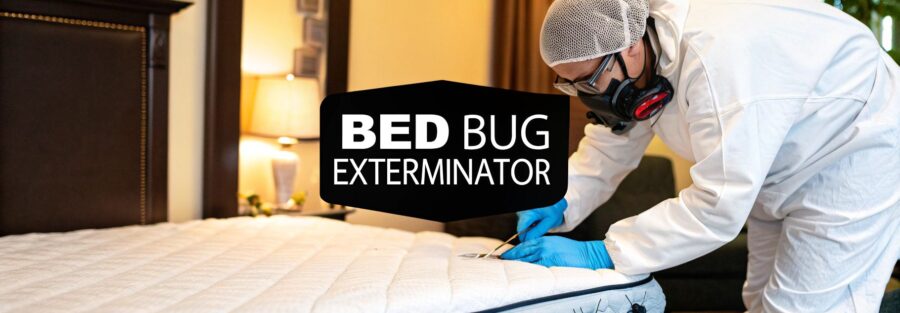That sinking feeling when you spot a bed bug is something else. Your first instinct is probably to grab your phone and search for an "exterminator for bed bugs near me," and you'd be absolutely right to do so. While the urge to tackle it yourself with store-bought sprays is strong, it's a battle you're unlikely to win alone.
DIY methods often just scatter the problem, leading to a frustrating, expensive, and stressful cycle. For a permanent solution, you need a professional.
Why You Need a Professional Bed Bug Exterminator

Finding even one bed bug can turn your home from a sanctuary into a source of constant anxiety. These pests are masters of survival. They can hide in the tiniest cracks, live for months without a meal, and have developed resistance to many of the pesticides you can buy off the shelf.
And if you think it's a rare problem, think again. Bed bugs have made a huge comeback across the UK. In 2023, councils dealt with over 14,587 bed bug callouts, a jump of 23% from the year before. This isn't about cleanliness; it's a widespread issue fuelled by travel and modern living.
The Limits of DIY Treatments
When you're faced with an infestation, it's natural to want to act fast. But those quick fixes from the hardware shop often do more harm than good.
- Foggers and Sprays: These mostly kill the adult bugs they touch directly. The eggs and nymphs hiding away in crevices are left completely unharmed, ready to start the cycle all over again.
- Diatomaceous Earth: This can work, but it's a slow process that requires perfect application. All the while, the infestation is growing and spreading.
- Incomplete Eradication: This is the biggest danger. You think you've solved it, you relax, and a few weeks later, they're back—often in greater numbers.
A professional exterminator brings the specialised equipment and, crucially, the experience needed to target bed bugs at every single stage of their life. They have access to treatments that are simply not available to the public.
While you're arranging for professional help, there are a few things you can do to start containing the problem without making it worse.
Immediate Actions After Finding Bed Bugs
| Action | Why It Matters | Expert Tip |
|---|---|---|
| Isolate infested items. | Place infested bedding, clothing, or small items in sealed plastic bags. | Don't move items from an infested room to a clean one. You'll just spread the problem. |
| Wash and dry on high heat. | Wash bagged items at 60°C and dry on high for at least 30 minutes. Heat kills all life stages. | This is a safe and effective way to treat fabrics before the professionals arrive. |
| Vacuum thoroughly. | Use a vacuum with a HEPA filter on mattresses, carpets, and furniture. Focus on seams and crevices. | Immediately empty the vacuum contents into a sealed bag and dispose of it outside your home. |
| Reduce clutter. | A cluttered room provides more hiding spots. | This will make the professional treatment more effective by exposing more areas. |
The Professional Advantage
Hiring a qualified exterminator gives you access to proven, powerful solutions. A pro will start with a thorough inspection, checking everywhere from mattress seams and bed frames to skirting boards and electrical outlets. This is vital for creating a treatment plan that actually works.
One of the most effective methods is professional heat treatment, which kills bed bugs at all life stages without chemicals. Ultimately, investing in an expert saves you time, money, and the immense stress of a recurring infestation. It’s the only way to be sure your home is truly pest-free.
How to Find and Vet Local Bed Bug Specialists

When you're dealing with bed bugs, the quality of the professional you hire makes all the difference. Your search probably kicked off with a frantic "exterminator for bed bugs near me," and that’s a great starting point. The real challenge, though, is sifting through the results to find a genuine expert who can get the job done right the first time.
Think of it like hiring any other skilled tradesperson. You can't just pick the first ad you see. It's about transforming that initial panic into a calm, methodical process to find someone you can trust.
Look for Professional Accreditations
The UK pest control industry is largely self-regulated, which makes professional memberships absolutely essential. They’re your first and best indicator of a company’s competence, training, and ethical standards.
The non-negotiable credential here is membership in the British Pest Control Association (BPCA). BPCA-affiliated companies are audited against a strict set of standards, proving they are properly insured, highly trained, and follow industry best practices. A quick check for their logo can instantly filter out the cowboys.
Some technicians might also hold qualifications from the Royal Society for Public Health (RSPH), which is another big tick in the box, showing a real commitment to professional development.
Reading Online Reviews with a Critical Eye
Online reviews on sites like Google or Trustpilot are a goldmine of information, but you have to learn to read between the lines. Don't just glance at the star rating; dive into what people are actually saying.
- Look for detail: A vague, one-liner like "Great service!" doesn't tell you much. You want to see reviews that describe the specific problem, what the technician did, and the final outcome. Did they mention if the person was thorough, punctual, and easy to talk to?
- Spot the red flags: A pattern of negative comments about recurring infestations, poor communication, or unexpected charges is a massive warning sign.
- Check the dates: Be wary of a sudden flood of generic five-star reviews posted in a short space of time—it could be a sign of fake testimonials. Authentic reviews tend to build up steadily over months and years.
A single bad review isn’t necessarily a deal-breaker, especially if the company has replied professionally and tried to resolve the issue. How a business handles criticism tells you a lot about their customer service.
Ask for Local and Recent References
Once you've got a shortlist, don't be shy about asking for references. Any reputable company will be more than happy to put you in touch with recent clients who've dealt with a similar pest issue. Speaking directly to a past customer gives you a level of insight that an online review just can't match.
Ask them about their experience with the company's communication, professionalism, and—most importantly—the long-term effectiveness of the treatment.
For a clearer picture of a company's expertise, it’s also a good idea to check out their website. Exploring a full list of their professional pest control services can show you the full scope of their capabilities. This final step gives you real-world validation of their skills, helping you make that final decision with total confidence.
Essential Questions to Ask Any Potential Exterminator
Once you’ve got a shortlist of local companies, the phone calls begin. This is where you separate the real pros from the cowboys. Going beyond a quick price check is absolutely vital—the right questions will reveal their experience, clarify their methods, and set proper expectations from the start.
Remember, this isn’t just about hiring a service. You’re bringing someone into your home to solve a deeply stressful problem. A true professional will welcome your questions and have clear, confident answers ready.
Questions About Their Experience and Specialisation
Not all pest control is created equal. Bed bugs are notoriously tricky, so you need a specialist, not a generalist who just dabbles. It's time to dig into their specific expertise.
- How much of your day-to-day work is actually bed bug extermination? You want to hear that it's a significant chunk of their business, ideally 30-50% or more. If it’s just an occasional side job for them, walk away.
- Are your technicians specifically trained and certified for bed bug control? General pest control tickets are a start, but specialised training from organisations like the BPCA (British Pest Control Association) shows they’ve gone the extra mile.
- Can you walk me through your process for a situation like mine? A good answer will sound like a clear, systematic plan: inspection, proper identification, a tailored treatment strategy, and follow-up. Vague, hand-wavy answers are a massive red flag.
Understanding the Proposed Treatment Plan
The how is just as important as the who. Different treatments have their own pros, cons, and requirements, and you need to know exactly what you’re signing up for.
Don’t settle for a one-size-fits-all pitch. A reputable exterminator will explain why they’re recommending a specific treatment—like heat or a particular chemical approach—based on how bad your infestation is, your type of property, and your family's circumstances.
Here are the key questions to get to the bottom of their plan:
- What treatment methods do you use, and which one are you recommending for my home? Why? This question forces them to show they’ve actually thought about your specific problem.
- Are the chemicals you use safe for children and pets? What do we need to do? They should give you clear, non-negotiable instructions on when to leave the property, for how long, and what cleaning is needed afterwards.
- How many follow-up visits are included in the price? One visit is almost never enough to kill bed bugs for good. A proper plan should always include at least one or two follow-up inspections and top-up treatments.
Now, while a professional treatment is the only way to get rid of an active infestation, what you do afterwards is crucial. This is your long-term defence.

Think of it as a simple loop: inspect, protect, and monitor. Turning these actions into a habit is the best way to create a powerful barrier against any future problems.
Clarifying Guarantees and Your Responsibilities
Finally, let's talk about the small print and your role in the process. Getting this wrong can lead to failed treatments, extra costs, and a lot of frustration.
Ask them straight up: What kind of service guarantee do you offer? You’re looking for a clear promise that outlines what happens if the bed bugs come back within a specific window (e.g., 30-90 days). And whatever they say, get it in writing.
Just as important is knowing what they expect from you. Ask for a detailed prep sheet. If you don't complete these tasks—like laundering all your clothes at a high temperature or decluttering infested areas—you could easily void your guarantee and undermine the entire treatment.
Before we get to the questions, it's worth understanding what treatments they might suggest.
Comparing Professional Bed Bug Treatments
Most professionals rely on a few core methods. Knowing the basics will help you understand their recommendations and ask smarter questions.
| Treatment Method | How It Works | Best For | Potential Downsides |
|---|---|---|---|
| Heat Treatment | The entire room or home is heated to over 50°C, killing bugs and eggs at all life stages instantly. | Severe infestations, chemical-sensitive environments, and for a quick, one-day result. | Can be expensive; requires significant preparation; may not be suitable for all types of properties. |
| Chemical/Insecticide | Residual sprays and dusts are applied to cracks, crevices, furniture, and other hiding spots. | Targeted control, long-lasting residual effect, and often more budget-friendly. | May require multiple visits; some bugs may have resistance; requires vacating the property. |
| Steam Treatment | High-temperature steam is applied directly to surfaces like mattresses and furniture to kill bugs and eggs on contact. | Spot-treating specific items and surfaces without chemicals. | Labour-intensive; steam can't penetrate deep into walls or dense clutter. |
| Integrated Approach | Combines multiple methods, such as steam for immediate kills on furniture and chemicals for residual protection. | The most comprehensive and effective approach for stubborn infestations. | Can be the most expensive option, but offers the highest success rate. |
Ultimately, the best companies often use an integrated approach, hitting the problem from multiple angles to ensure nothing is left behind.
Understanding Bed Bug Extermination Costs
Let's talk about the elephant in the room: the cost. When you’re suddenly facing a pest problem, your budget is a genuine concern. The price for a professional bed bug exterminator can feel a bit daunting, but it's far better to think of it as an investment in a permanent solution.
The final figure isn't a simple, one-size-fits-all number. It’s actually built around several key factors that are unique to your situation.
What Influences the Final Quote
First off, the size of your property plays a huge role. It’s just common sense that treating a one-bedroom flat will cost less than clearing out a four-bedroom house. The severity of the infestation is another critical piece of the puzzle. A small, localised problem you've caught early is far simpler—and cheaper—to deal with than a widespread infestation that’s already spread to multiple rooms and deep into your furniture.
The treatment method we choose will also heavily impact the cost. For example, a full heat treatment is often more expensive upfront than traditional chemical sprays. The trade-off? It can solve the entire problem in a single day. In contrast, chemical treatments might need two or three separate visits to be fully effective, and the total cost will naturally reflect the labour and materials for each appointment.
Here are the main things that will shape your quote:
- Property Size: The larger the area we need to treat, the higher the cost.
- Infestation Level: A light infestation needs a different level of intervention than a severe one.
- Treatment Method: Heat, chemical, and integrated approaches all come with different price tags.
- Number of Visits: A proper, comprehensive plan should always include follow-up visits, which are factored into the initial quote.
A word of warning: be very wary of any quote that seems unusually low. A price that looks too good to be true often signals a cheap, single-visit treatment that’s highly unlikely to eradicate the problem for good. You'll just end up back at square one a few weeks later.
The Decline of Council Pest Control
In the past, many people would have just turned to their local council for help. Unfortunately, for most of us, this is no longer a reliable option. With bed bug infestations in the UK surging, many local authorities have been forced to scale back or even eliminate their pest control services altogether due to brutal budget cuts.
Recent research shows that an astonishing 24% of UK councils have either stopped offering pest control services or never did in the first place, leaving residents to fend for themselves. This shift makes finding a trustworthy private exterminator for bed bugs near you more critical than ever.
Costs for private services can vary wildly, from as little as £10 for very minor issues to over £280 for more complex jobs, which really highlights why getting a detailed, transparent quote is so important. You can dig into more data on UK pest trends in this detailed report from The Independent. Today, investing in a professional service isn't a choice—it's a necessity.
Preparing Your Home for a Successful Treatment

Getting rid of bed bugs for good is a genuine partnership. We bring the professional-grade tools and expertise, but the success of any treatment really hinges on how well you prepare your home beforehand. Proper prep work is what allows our treatments to reach every last crack and crevice where these pests hide.
Think of it this way: we can't treat what we can't get to. A cluttered room is a bed bug's paradise, offering an endless buffet of hiding spots that are totally inaccessible to sprays or heat. Following a structured prep plan is your way of tipping the odds firmly in our favour, leading to a faster, more effective, and lasting result.
Your Essential Preparation Checklist
Your exterminator will give you a specific checklist, but the core jobs are pretty consistent. The main goal is simple: reduce clutter and expose all potential hiding spots, especially in high-activity areas like bedrooms and living rooms.
- Strip All Beds: Take off everything – sheets, duvet covers, pillowcases, and mattress protectors. Crucially, don't carry them through the house.
- Bag Everything: Put all that bedding and any clothes from nearby wardrobes or drawers straight into sealed plastic bags. This stops any bugs from escaping and spreading.
- Clear the Floor: Get everything off the floor, paying close attention to the space under beds and inside wardrobes. This means dealing with boxes, shoes, and any other loose items.
This initial decluttering is the most important step you can take. It turns a complex, bug-friendly environment into a simple one, giving the treatment the best possible chance of reaching every single bug and egg.
The Importance of High-Heat Laundering
Heat is the ultimate enemy of the bed bug. It kills every life stage, from the tiny, resilient eggs to the adult insects, which is why a thorough laundry session is a non-negotiable part of the prep.
All your bagged fabrics—clothing, bedding, curtains, even the kids' soft toys—need to be washed and dried at the highest possible temperature. You're aiming for a wash cycle of at least 60°C, followed by a minimum of 30 minutes in a tumble dryer on a high heat setting.
Once everything is clean and dry, place the items into fresh, clean plastic bags and seal them up tight. Don't bring them back into the treated rooms until your technician gives you the all-clear.
Remember: Don't be tempted to skip the tumble drying. The intense, sustained heat of a dryer is often more critical than the wash cycle itself for making sure every last bug and egg is destroyed.
Final Steps Before Treatment
With the laundry sorted, there are just a few final things to do. Pull all furniture at least half a metre away from the walls. This simple move gives your technician total access to skirting boards, plug sockets, and other common hiding places.
Finally, give all carpets, rugs, and upholstered furniture a thorough vacuuming. Pay extra attention to mattress seams, the bed frame, and the edges of the room. As soon as you’re done, empty the vacuum’s contents into a sealed plastic bag and get it into an outside bin immediately.
Following these steps is vital for a successful outcome. To see how this fits into our wider strategy, you can learn more about our professional bed bug treatment process and how we work with you to guarantee complete eradication. Your cooperation truly makes all the difference.
So, the Exterminator Has Gone. Now What?
The treatment is done, and you can finally breathe a sigh of relief. While the professionals have done the heavy lifting, your job isn't quite over. What you do in the next few hours, days, and weeks is absolutely critical to making sure those bed bugs are gone for good.
This is all about being vigilant and proactive. Your technician will have left you with a clear set of instructions—things like when it’s safe to go back inside and when you can start cleaning again. Follow this advice to the letter. It’s non-negotiable for both your safety and the treatment's success.
Keep a Watchful Eye
Don't be alarmed if you spot a few stray bed bugs in the days after the treatment. It's actually pretty normal. These are the last few survivors stumbling out of their hiding spots after being exposed to the treatment, and they won't last long.
That said, you need to stay on top of it. Any good exterminator will have already booked in a follow-up visit, usually for about two or three weeks' time. This is essential. They'll check for any fresh signs of activity and, if necessary, apply a second treatment to catch any newly hatched nymphs that might have survived the first round.
This isn't the time to get complacent. Consistent monitoring is your best weapon against a comeback. For the first couple of months, make a weekly habit of checking all the usual hiding spots—mattress seams, the headboard, and behind skirting boards.
Playing the Long Game: Prevention
Once your home has the official all-clear, your focus needs to shift to making it as unwelcoming for bed bugs as possible. A few simple habits can create a powerful, lasting barrier against a future infestation.
- Wrap Up Your Mattresses: Get high-quality, bite-proof and escape-proof encasements for all your mattresses and box springs. Do it immediately. This traps any bugs left behind and stops new ones from moving in.
- Travel Smart: Before you even think about unpacking in a hotel room, give it a quick inspection. Check the mattress, headboard, and luggage rack. When you get home, unpack your suitcase in the garage or outside, and throw all your clothes straight into the wash on a high-heat cycle.
- Think Twice About Second-Hand Finds: Never bring second-hand furniture home without giving it a thorough, almost forensic, inspection first. This goes double for mattresses or any upholstered items.
Preventing a return is especially important in busy urban centres. London, for example, has become a real hotspot for bed bugs, thanks to its dense population and constant flow of travellers. In fact, infestations in some London boroughs have been climbing by 20-30% each year, making professional prevention more of a necessity than a luxury. You can find out more about bed bug trends in major UK cities on Pest.co.uk.
By staying proactive, you can finally break the cycle and get that lasting peace of mind you deserve.
Ready to make sure your home stays bed bug-free for good? Contact Pest Predators Limited today for a full consultation and expert-led prevention strategies. Let our scientific approach protect your peace of mind. Visit us at https://www.pestpredatorslimited.co.uk.



